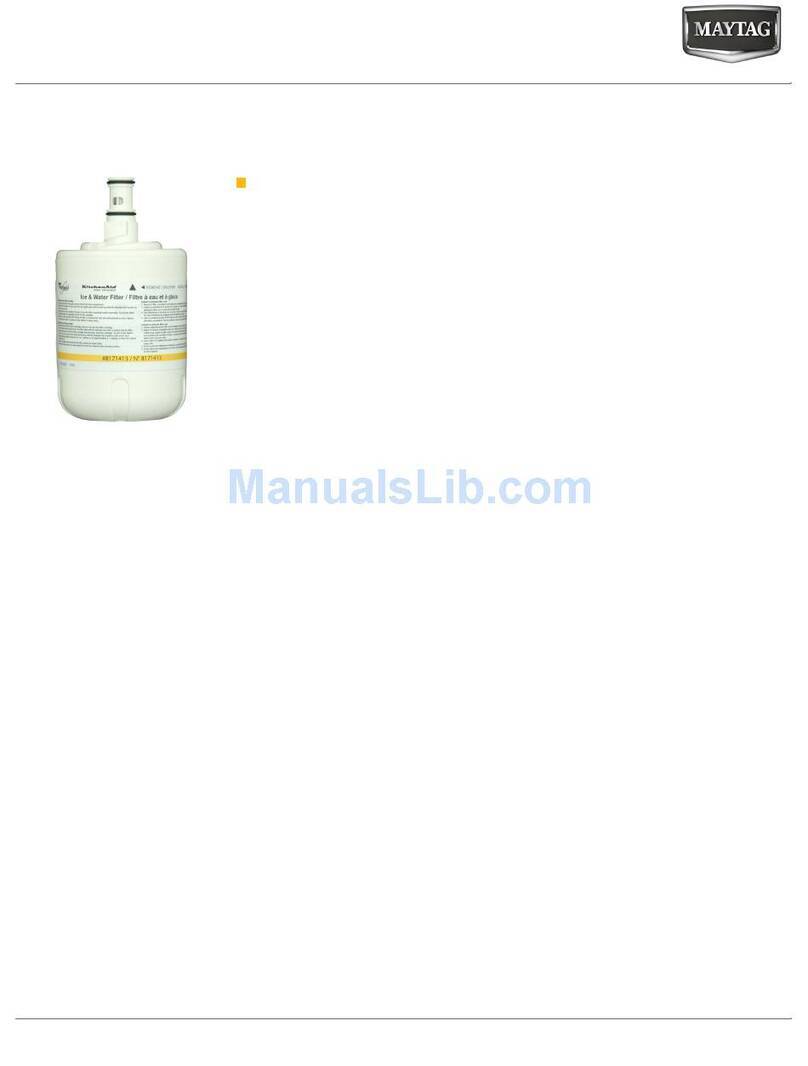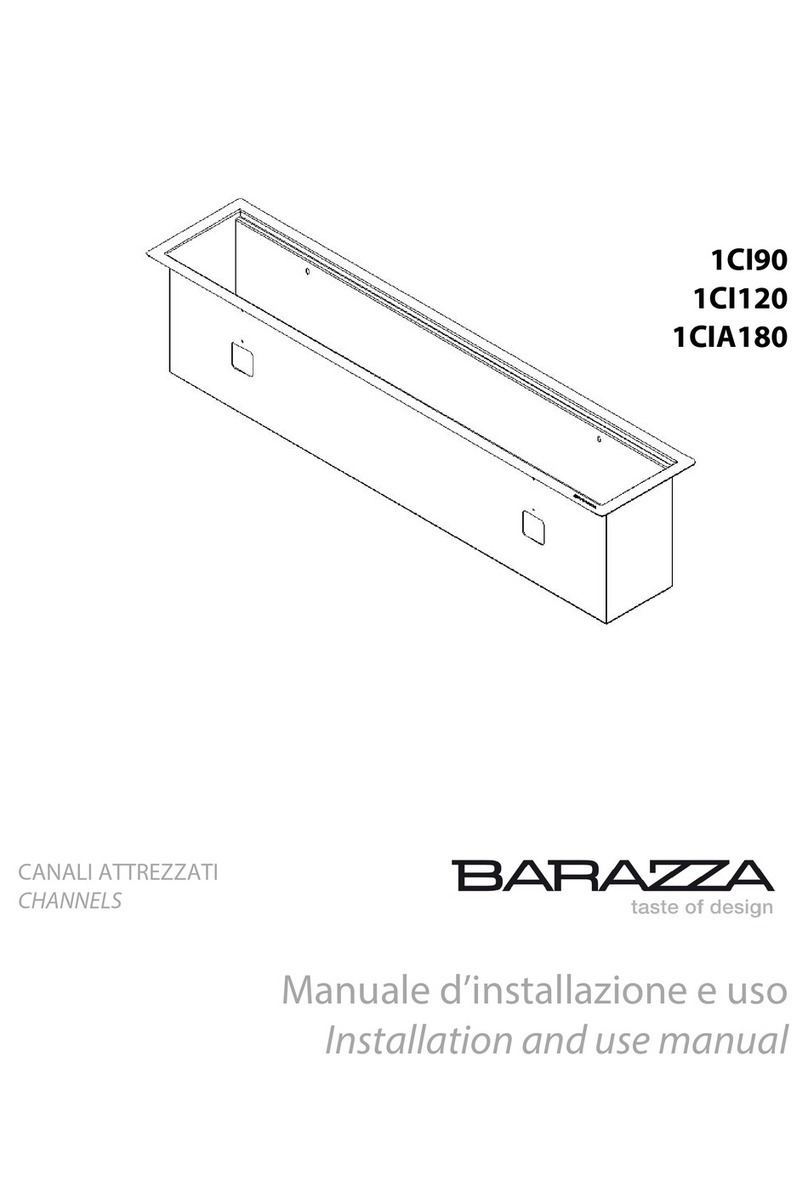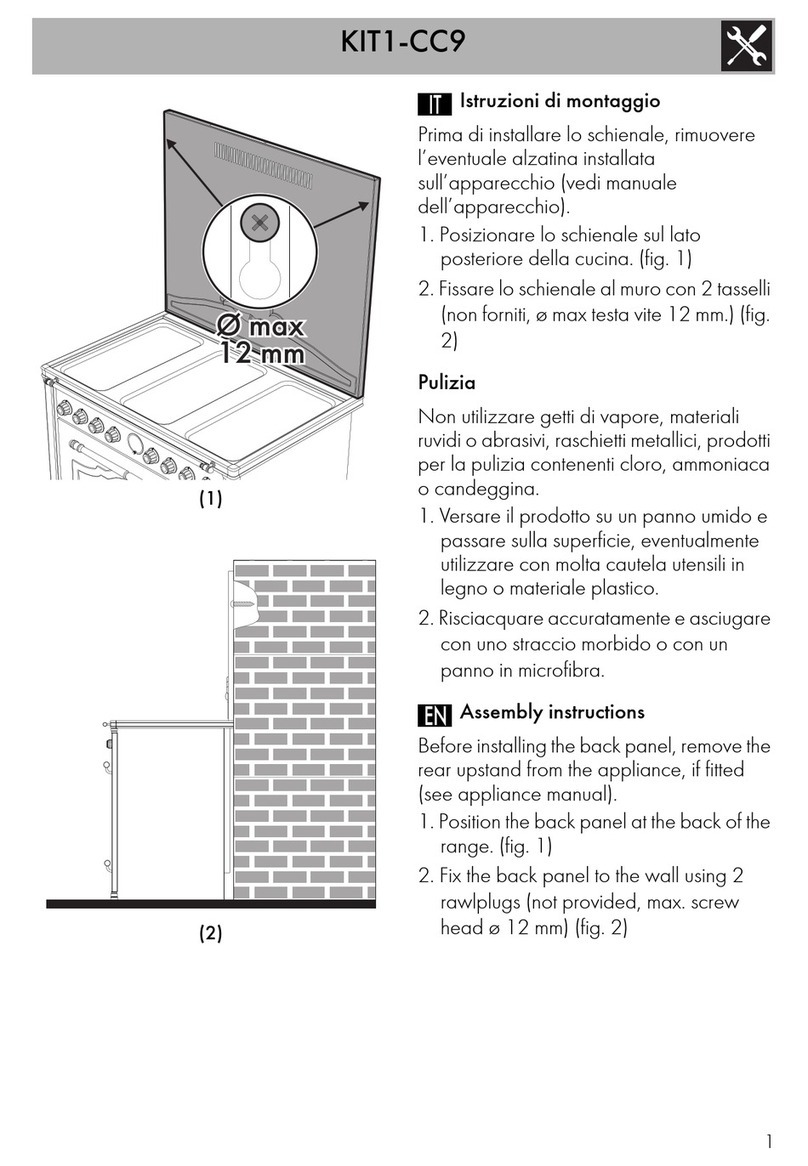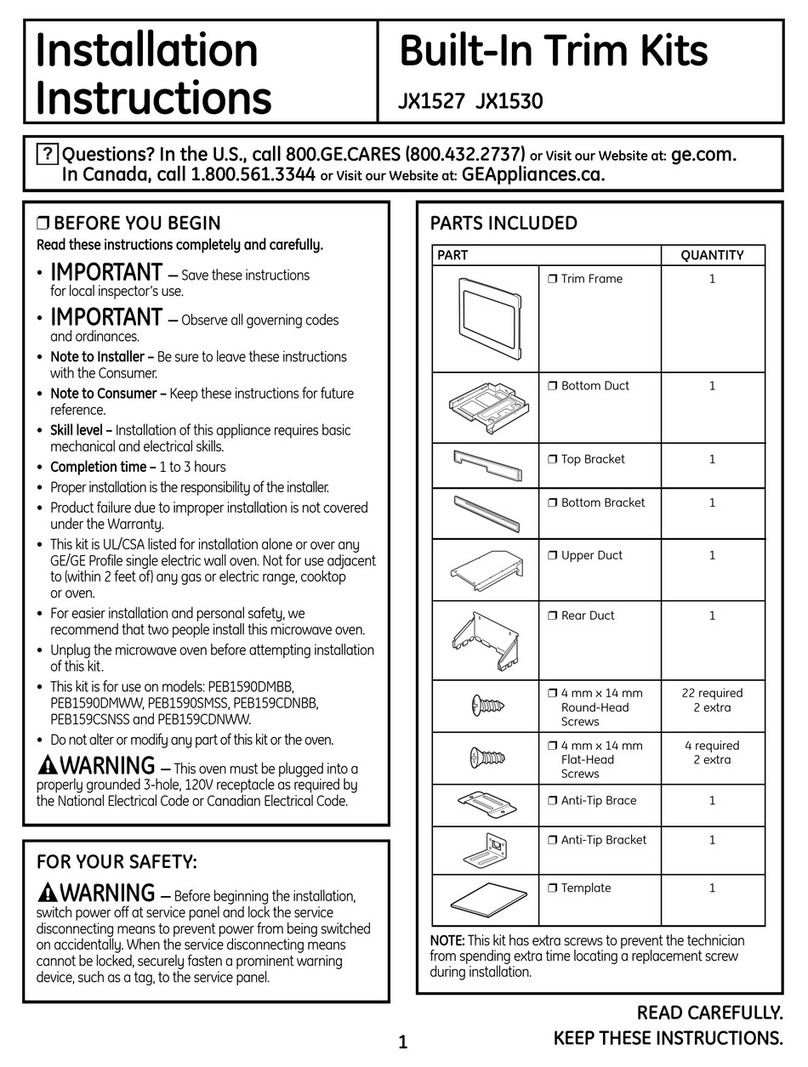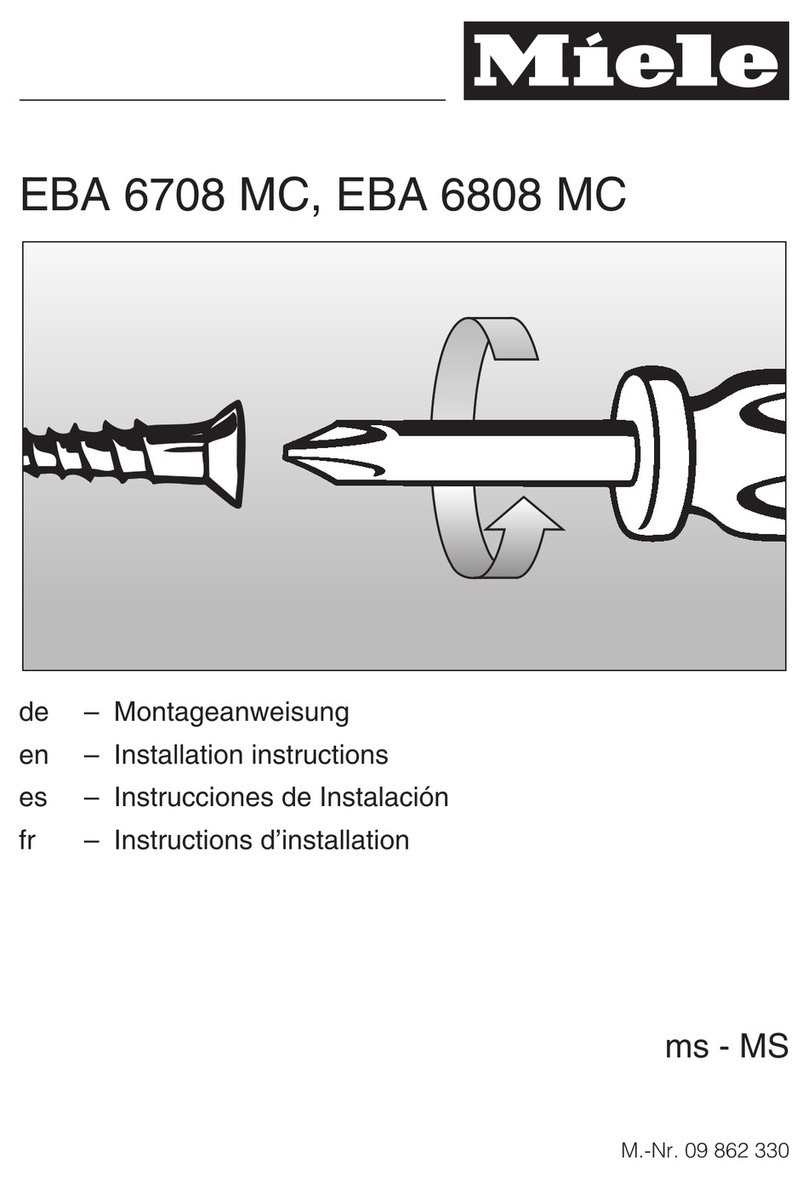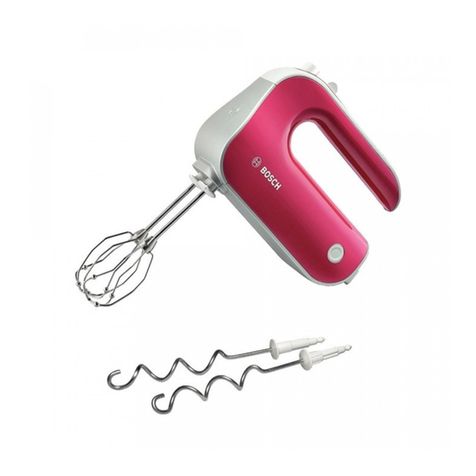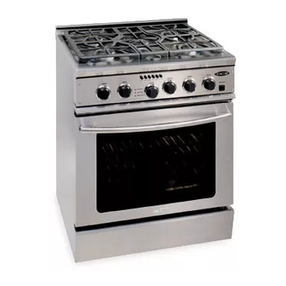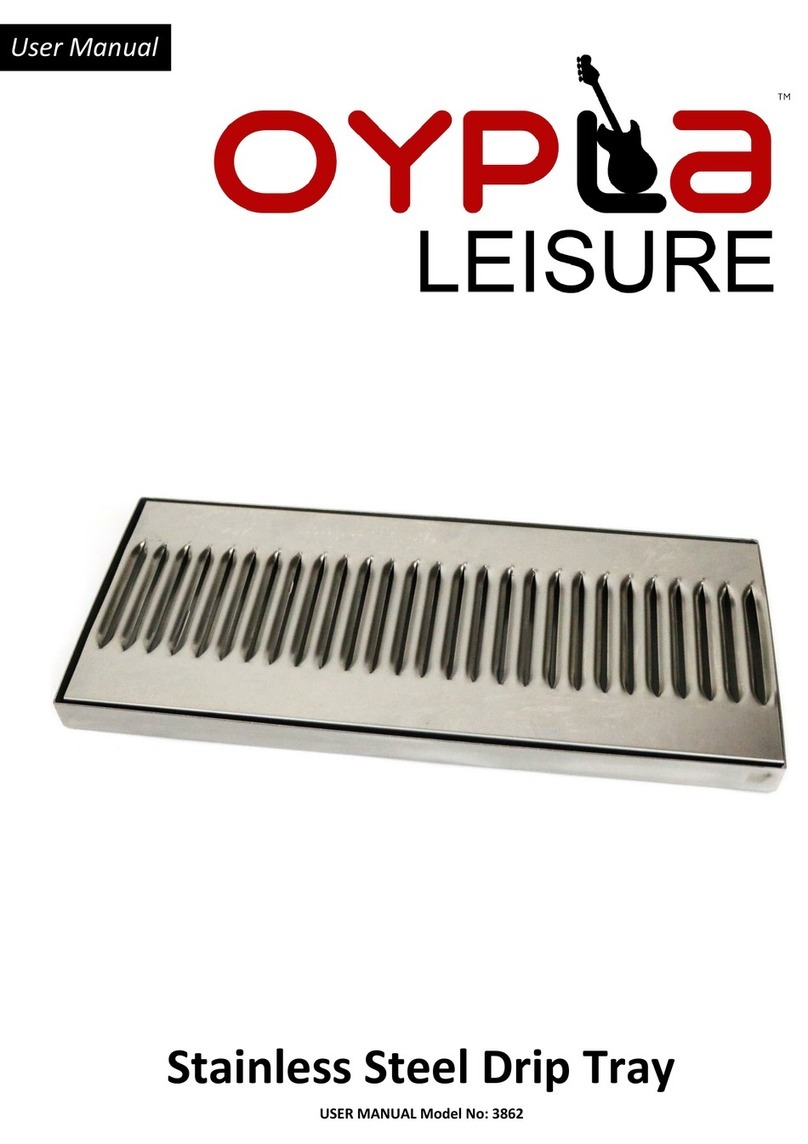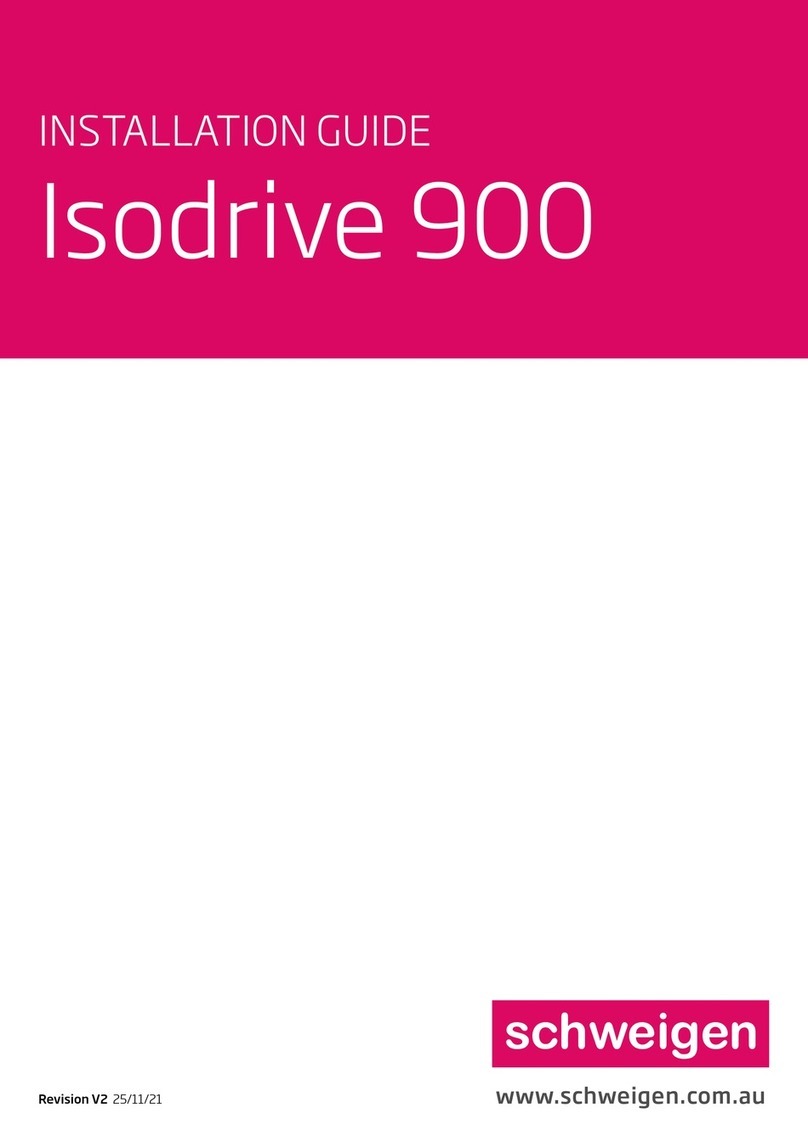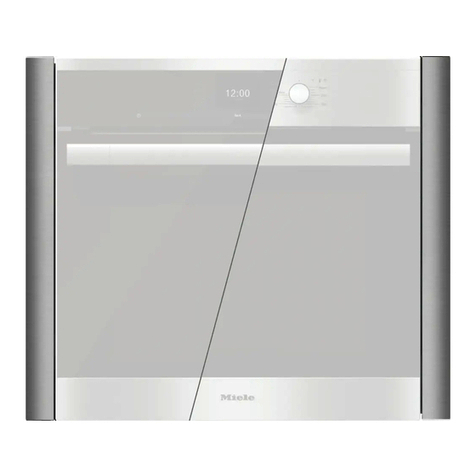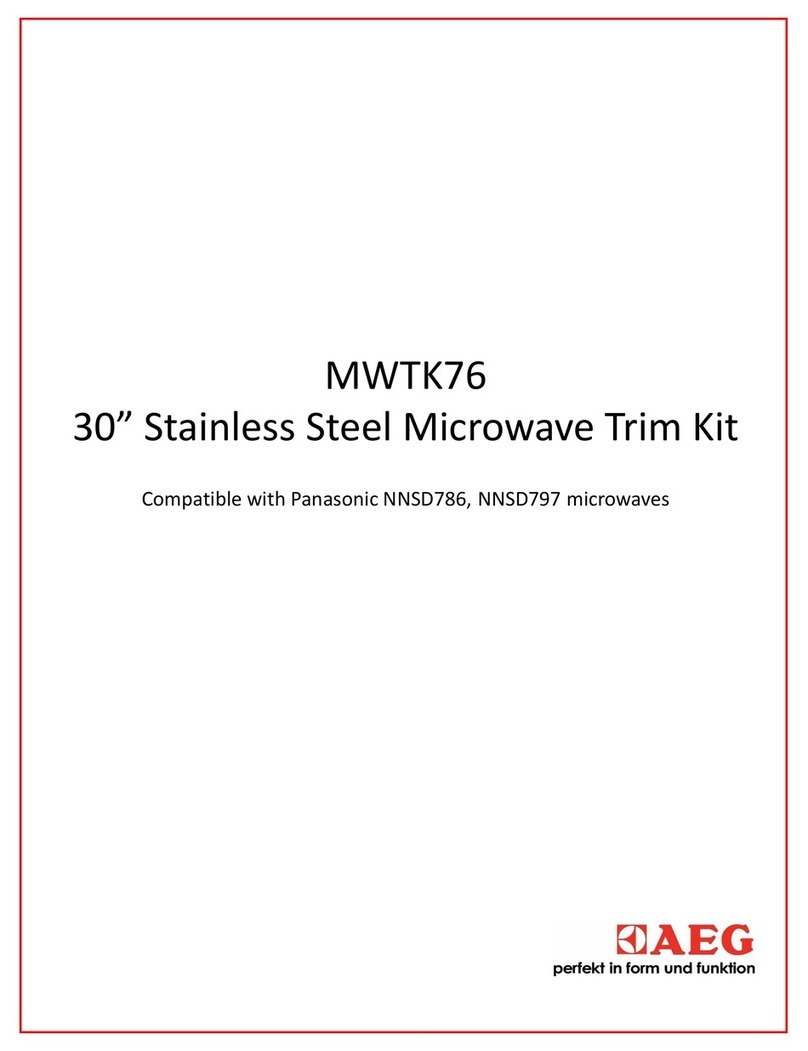Chef's Choice Sportsman Xtreme Diamond Hone 317 User manual

MODEL 317 InstructIOns
Xtreme™
Diamond Hone®Sharpener
RUGB
Read these instructions before use.
It is essential that you follow these
instructions to achieve optimum results.
© 2016 EdgeCraft Corp.

2
IMPORTANT SAFEGUARDS
When using electrical appliances, basic safety precautions should always be
followed including the following:
1. Read all instructions.
2. To protect against electrical hazards do not immerse the Chef’sChoice®in water or
other liquid.
3. Make sure that only clean knife blades are inserted in the Chef’sChoice®.
4. Unplug from outlet when not in use, before putting on or taking off parts and
before cleaning.
5. Avoid contacting moving parts.
6. Do not operate any appliance with a damaged cord or plug or after the appliance
malfunctions, or is dropped or damaged in any manner.
U.S. customers: You may return your sharpener to EdgeCraft’s factory for service where
the cost of repair or electrical or mechanical adjustment can be estimated. When the
electrical cord on this appliance is damaged, it must be replaced by the Chef’sChoice
distributor or other qualified service to avoid the danger of electrical shock.
Outside the U.S.: Please return your sharpener to your local distributor where the cost of
repair or electrical or mechanical adjustment can be estimated. If the supply cord of this
appliance is damaged, it must be replaced by a repair facility appointed by the manufac-
turer because special tools are required. Please consult your Chef’sChoice distributor.
7. CAUTION! “This appliance may be fitted with a polarized plug (one blade is wider than
the other). To reduce the risk of electric shock, this plug will fit in a polarized outlet
only one way. If the plug does not fit fully in the outlet, reverse the plug. If it still does
not fit, contact a qualified electrician. Do not modify the plug in anyway.”
8. The use of attachments not recommended or sold by EdgeCraft Corporation may
cause fire, electric shock, or injury.
9. The Chef’sChoice®Model 317 is designed to sharpen most sports knives, pocket
knives and kitchen knives. Do not attempt to sharpen scissors, ax blades or any blade
that does not fit freely in the slots.
10.Do not let the cord hang over edge of table or counter or touch hot surfaces.
11.When in the “ON” position (Red flash on switch is exposed when “on”) the
Chef’sChoice®should always be on a stable countertop or table.
12.WARNING: KNIVES PROPERLY SHARPENED ON YOUR CHEF’SCHOICE®WILL BE
SHARPER THAN YOU EXPECT. TO AVOID INJURY, USE AND HANDLE THEM WITH
EXTREME CARE. DO NOT CUT TOWARD ANY PART OF YOUR FINGERS, HAND OR BODY.
DO NOT RUN FINGER ALONG EDGE. STORE IN A SAFE MANNER.
13.Do not use outdoors.
14.Close supervision is necessary when any appliance is used by or near children.
15.Do not use honing oils, water or any other lubricant with the Chef’sChoice®.
16.For household use only.
17.SAVE THESE INSTRUCTIONS.

3
YOU MADE
A GOOD
CHOICE
Outdoor enthusiasts, professional chefs and serious cooks world-wide rely
on Chef’sChoice®Diamond Hone®sharpeners to maintain high performance
multi-bevel edges on their favorite cutlery. Now with your Chef’sChoice®
Sportsman Xtreme Model 317 you will share the professional’s advantage
with knives of astonishing sharpness and durability. The Xtreme™317
incorporates the latest sharpening technology developed by EdgeCraft—
including a guide system particularly designed to easily sharpen thick hunting
and tactical knives, in addition to all your other knives.
You will find the Model 317 extremely fast and simple to use. It is safe to use
on all quality sporting, kitchen and pocket knives. Please read this instruction
booklet thoroughly before you use the sharpener in order to optimize your
sharpening results.
As an owner of the Xtreme™317 you have the means to create edges of a
perfection, sharpness and durability heretofore unobtainable with even the
world’s most expensive commercial sharpening systems. You will find it is a
joy to sharpen and use your knives. Remember, a sharp knife is a safe knife
because you expect it to be sharp, you respect it and it requires less force to
cut. But remember, the edge is incredibly sharp!
The Chef’sChoice®Diamond Hone®317 sharpener creates demonstrably
superior multifacet edges on knives of any steel - carbon, stainless, or alloy
of any hardness. Edges sharpened on the Model 317 are much sharper and
stay sharp longer than conventional and hollow ground edges.
You can easily and very quickly sharpen the entire cutting edge of your
favorite knives, from the tip to the handle or bolster. The highly precise edges
will reward you with years of superior knife performance.

4
UNDERSTANDING THE XTREME™317
DIAMOND HONE®SHARPENER
The unique Chef’sChoice®Diamond Hone®Sharpener is designed to sharpen knives with
either straight or serrated edges.This two (2) stage sharpener has a precision conical sharpening
/ honing stage with fine 100% diamond abrasives and a unique polishing/stropping stage
using proprietary flexible abrasive disks. This combination can be used to create either an
astonishingly sharp, smooth faceted edge for effortless cutting and presentations or one with a
selected amount of residual “bite” along the facets.
The sharpening and honing actions are controlled by using precisely angled guides for the blade
and precisely matched conically surfaced abrasive disks. The sharpening angle is slightly larger
in Stage 2 than in Stage 1.
Fine diamond-coated conical disks in Stage 1 create microgrooves along the facets on each
side of the edge establishing the first angled bevel of the edge.
In Stage 2 ultrafine abrasive disks polish and strop the facets immediately adjacent to the
edge creating a microbevel and establish a microscopically thin straight and super polished
edge of astonishing sharpness. The stropping action simultaneously polishes and sharpens the
boundaries of those microgrooves created by the diamond abrasives in Stage 1, adjacent to the
edge, until they become sharp micro flutes that will assist the cutting action with “difficult to
cut” materials.
This unique two stage design gives you an edge of remarkable sharpness and because of the
second angle bevel it creates, you will note knives stay sharp longer than those sharpened by
conventional methods.
The following sections describe the general procedures for optimal sharpening. One of the
important advantages of using the Xtreme™317 is that you can strop and polish your knives
to razor sharp edges as often as needed and yet experience little knife wear compared to older
sharpening methods. Resharpening can commonly be done by using just the stropping action of
Stage 2. (See Resharpening Section).
The Xtreme™317 Sharpener is equipped with manually activated diamond dressing pads that
can be used if necessary to clean any accumulated food or sharpening debris off the surface
of the polishing/stropping disks. We strongly urge you to clean knives before sharpening them.
You will find you can go months or over a year before you need to dress these disks. Only if you
sense a distinct decrease in polishing efficiency will there by any need to use this convenient
feature described further in a subsequent section.

5
Each sharpening Stage is equipped with elastomeric profiled guide springs positioned over the
sharpening disks to provide a spring action that holds the face of your knife securely against the
precision guides in the right and left slots of each stage during sharpening.
You will want to sharpen equally in the right and left slots of each stage you use. This will ensure
that the facets on each side of the edge are of equal size and that the edge will cut straight at
all times.
When sharpening in either stage, the knife should, on sequential strokes, be pulled alternately
through the left slot and the right slot of that Stage. Generally only one or two pairs of pulls
(alternating in the left and right slots) will be adequate in each stage (see subsequent sections for
more detail). Always operate the sharpener from the front side. Hold the blade horizontal and level
and slide it down between the plastic spring and the guide plane while pulling it toward you at a
uniform rate as it contacts the sharpening or stropping disk. You will be able to feel and hear the
contact with the disk as it is made. Always keep the blade moving uniformly through each stage;
do not stop the pull in mid stroke. Consistently pull at a speed of about 5 seconds per stroke for
an eight (8) inch blade. The time can be less for shorter blades and more for longer blades.
Never operate the sharpener from the back side.
Use just enough downward pressure when sharpening to ensure uniform and consistent contact
of the blade with the abrasive disks on each stroke. Additional pressure is unnecessary and will
not speed the sharpening process. Avoid cutting into the plastic enclosure. Accidental cutting
into the enclosure will not functionally impact operations of the sharpener or damage the edge.
Figure 1 below identifies each of the two stages as described further in the following sections.
Figure 2. Typical hunting knife.
Heel
Handle
Edge
Tip
Figure 1. Model Xtreme™317 Diamond Hone®Sharpener.
Stage 1 Stage 2
Spring

6
INSTRUCTIONS
READ THIS BEFORE YOU START TO SHARPEN
The Xtreme™Model 317 is designed to sharpen most tactical, hunting, pocket, kitchen or
serrated edge blades.
1. Sharpen Serrated Blades Only in Stage 2. Do not sharpen serrated blades in Stage 1
until you read section titled Procedure for Sharpening Serrated Blades.
2. Straight Edge Blades are sharpened in Stages 1 and 2. Start in Stage 1 if the knife is
being sharpened for the first time or if the knife is very dull. See following Section for
more details.
PROCEDURE FOR SHARPENING STRAIGHT EDGE BLADES
STRAIGHT EDGE BLADES: SHARPENING FIRST TIME
Before you turn on the power, slip a knife blade smoothly into the slot between the left angle
guide of Stage 1 and the elastomeric spring. Do not twist the knife. (See Figure 3.)
Move the blade down in the slot until you feel it contact the diamond disk. Pull it towards you
lifting the handle slightly as you approach the tip. This will give you a feel for the spring tension.
Remove the knife and press the Power Switch. A red “indicator” on the switch appears when
this switch is turned “ON.”
Stage 1: If you are sharpening a knife for the first time, start in Stage 1. Pull the knife once
through the left slot of Stage 1 (Figure 3) by slipping the blade between the left angle guide
and the polymeric spring while pulling the blade toward you and simultaneously moving the
blade downward in the slot until it engages the diamond coated disk. You will hear it make
contact with the disk. Insert the blade as close as possible to its bolster or handle. If the blade is
curved, lift the handle slightly as you sharpen near the tip of the knife, keeping the blade edge
approximately parallel to the table. Sharpen the entire blade length. For an eight (8) inch blade
each pull should take about 6 seconds. Pull shorter blades through in 3-4 seconds and longer
blades in 8 seconds. Next, repeat with one full length pull in the right slot of Stage 1.
Note: Each time you insert the blade, simultaneously pull the blade toward you. Never push the
blade away from you. Apply just enough downward pressure to make contact with the wheel –
added pressure does not speed up the sharpening process.
Figure 3. Stage 1. Inserting blade in slot between guide
and elastomeric spring. Alternate individual pulls in left
and right slots.
Figure 4. Inserting blade in right slot of Stage 1.

7
To ensure uniform sharpening along the entire blade length, insert the blade near its bolster or
handle and pull it at a steady rate until it exits the slot. Always make an equal number of pulls
alternating one pull in the left slot and then one pull in the right slot in order to keep the edge
facets symmetrical. Generally in Stage 1 you will find that only 3-4 pairs of alternating pulls
is adequate.
Before moving to Stage 2 you will find it helpful to confirm that a burr (see Figure 5) exists along
one side of the edge. To check for the burr, move your forefinger carefully across the edge as
shown. (Do not move your finger along the edge – to avoid cutting your finger). If the last pull
was in the right slot, the burr will appear only on the right side of the blade (as you hold it)
and vice versa. The burr, when present, feels like a rough and bent extension of the edge; the
opposite side of the edge feels very smooth by comparison. If a burr exists along the entire edge,
proceed to Stage 2.
If no burr exists, make one (1) additional pull in the left and right slots of Stage 1 before
proceeding to Stage 2. Slower pulls will help you develop the burr. Confirm the presence of
the burr and proceed to Stage 2. It is always necessary to create the burr in Stage 1 before
stropping in Stage 2.
If the knife is extremely dull, additional pulls in Stage 1 may be needed before proceeding to
Stage 2.
Stage 2: In general only 2-3 pairs of alternating pulls in Stage 2 will be necessary to obtain a
razor sharp edge. Make alternate pulls in left (Figure 6) and right slots pulling the knife through
the slots at the same speed used in Stage 1.
Added pulls in Stage 2 will refine the edge further. Fewer pulls in Stage 2 may be preferable if
you will be cutting fibrous foods, detail in the following sections.
Burr
Figure 5. Develop a distinct burr along knife edge before
stropping in stage 2. Burr can be detected by sliding
finger across and away from the edge.
Caution! See text.
Figure 6. Inserting blade in left slot of Stage 2. Alternate
individual pulls in left and right slots.

8
OPTIMIZING THE KNIFE EDGE
FOR GAME, FISH AND FIBROUS MATERIALS
For cutting more fibrous materials you may find it advantageous to sharpen in Stage 1 –
followed directly by only one alternating pair of pulls in Stage 2. This will leave sharpened
microflutes along the facets nearer to each side of the edge (Figure 8) that will assist in the
cutting of such materials.
To prepare this type edge, sharpen in Stage 1 until a burr is developed along the entire edge.
Then move to Stage 2 and make just one pair of pulls.
To resharpen this type of edge, sharpen in Stage 1 until you develop a burr and then make one
pair of pulls in Stage 2.
PROCEDURE FOR SHARPENING SERRATED BLADES
Serrated blades are available in multiple sizes and shapes and can include full length and partial
length serrations. Serrations are formed by the manufacturers based on their design criteria, by
grinding scalloped depressions, or grooves on only one side of the blade.
The Model 317 sharpener will restore the pointed teeth of the serrations, which do most of the
cutting, and develop sharp microblades along the edge of these teeth.
If your serrated blade edge has light wear, then only minimal effort is required to re-sharpen the
edge, using only Stage 2 (see Figure 9). First you need to establish on which side of the blade
the serrations are formed. If the serrations are on the right side of the blade (as you would hold
the knife when cutting) then re-sharpen the blade in the right slot of Stage 2. Slowly pull the
knife (about 4-5 seconds per pull for an 8” blade, less for shorter blades and more for longer
ones) through the sharpener. The stropping/polishing disk in Stage 2 will only sharpen the non-
grooved side of the blade.
After 5 to 6 slow pulls through the right slot, finish by slowly pulling the knife through left slot of
Stage 2, two times. Then check the edge for sharpness. The above process may be repeated 2
to 3 times to get the desired results.
If the serrations are ground on the left side of the blade, then start by re-sharpening the blade
in the left slot of Stage 2, with 5 to 6 slow pulls, finishing with two slow pulls in the right side
of Stage 2.
Figure 7. A larger polished facet adjacent to edge is
ideal for gourmet preparations.
Figure 8. Retention of larger microflutes adjacent to
edge helps when cutting fiberous foods.

9
If the serrated edge is extremely worn or severely damaged, then the knife should first be pre-
sharpened in Stage 1. In this stage only sharpen the non-grooved side of the serrated blade,
as follows:
If the grooved serrations are on the right side of the blade (as you would hold the knife when
cutting), then only use the right slot of Stage 1. The reverse applies if the grooved serrations are
on the left side of the blade.
Only make 1 or 2 quick pulls (about 1 to 2 seconds each), through the appropriate slot of Stage
1. Then move on to Stage 2 and complete the sharpening as previously described in this section.
DRESSING TOOL FOR CLEANING OF STROPPING/POLISHING DISKS – STAGE 2
The Xtreme™317 is equipped with a built-in accessory to manually clean/dress the stropping
disks in Stage 2. In the event these disks become glazed with grease, food or sharpening debris,
they can be cleaned and reshaped by actuating the manual lever on the rear of the sharpener.
This lever is located within a recess as shown in Figure 10 on the left lower corner as you face
the rear of Model 317.
To actuate the cleaning/dressing tool, make sure the power is on and simply press the small
lever in the recess to the right or left and hold for 3 seconds. Then press the lever in opposite
direction and hold for 3 seconds. When the lever is moved in one direction, the dressing tool
cleans and reshapes the active surface of one stropping/polishing disk. By moving in the
opposite direction you clean the other disk.
Use this clean/dress accessory only if and when Stage 2 no longer appears to be sharpening
well or when it takes too many pulls to obtain a razor sharp edge. Using this tool removes
material from the surface of the Stage 2 disk and hence if used excessively will unnecessarily
remove too much of the abrasive surface – wearing the disks out prematurely. If that should occur,
factory replacement of the disks will become necessary.
If you clean knives regularly before sharpening, you will need to clean or dress the Stage 2 disks
only about once a year or perhaps less frequently.
RESHARPENING (SEE PREVIOUS SECTIONS)
Resharpen straight edge knives whenever practical using Stage 2. When that fails to quickly
resharpen, return to Stage 1 and make one or two pairs of alternating pulls. Check for a burr
along the edge and then return to Stage 2 where only one to two alternating pair of pulls will be
adequate to put a new razor-like edge on the knife.
Resharpen serrated blades in Stage 2. See sections above.
Figure 9. Sharpen serrated blades only in Stage 2.
Blade shown with serrations on left side of blade.
(See instructions).
Figure 10. Stage 2 disks can be cleaned if necessary.
Use infrequently. (See instructions).

10
SUGGESTIONS
1. Always clean all food,fat, and foreign materials from knife before sharpening or resharpening.
If soiled, wash the blade before sharpening.
2. Use only light downward pressure when sharpening – just enough to establish secure
contact with the abrasive disk.
3. Always pull the blades at the recommended speed and at a constant rate over length of blade.
Never interrupt or stop the motion of the blade when in contact with the abrasive disks.
4. Always alternate individual pulls in right and left slots (of any stage used). Specialized
Japanese blades are an exception and are sharpened primarily on one side of the blade.
5. The edge of the knife blade, while sharpening, should be held in a level position relative to
the top of the counter or table. To sharpen the blade near the tip of a curved blade, lift the
handle up slightly as you approach the tip so that each section along the curved length of the
edge as it is being sharpened is maintained “level” to the table.
6. There is no need or advantage to using a “sharpening steel” on knives sharpened on the
Xtreme™317. Consider resharpening with the manual Chef’sChoice®sharpener Model 464
if you are using knives at a remote location away from electrical power. It is recommended
that you keep the Model 317 readily accessible and resharpen often, as described in the
Sections above.
7. Used correctly, you will find you can sharpen the entire blade to within 1/8” of the bolster
or handle. This is a major advantage of the Xtreme™317 compared to other sharpening
methods – especially important when sharpening chef’s knives where you need to sharpen
the entire blade length in order to maintain the curvature of the edge line. If your chef’s
knives have a heavy bolster near the handle extending to the edge, a commercial grinder
can modify or remove the lower portion of the bolster so that it will not interfere with the
sharpening action allowing you to sharpen the entire blade length.
8. To increase your proficiency with the Xtreme™317, learn how to detect a burr along the
edge (as described on page 7w). While you can sharpen well without using this technique,
it is the best and fastest way to determine when you have sharpened sufficiently in Stage 1.
This will help you avoid oversharpening and ensure incredibly sharp edges every time. Cut-
ting a tomato or a piece of paper is a convenient method of checking for blade sharpness.

11
NORMAL MAINTENANCE
NO lubrication is required for any moving parts, motor, bearings or sharpening surfaces. There
is no need for water on abrasives. The exterior of the sharpener may be cleaned by carefully
wiping with a damp cloth. Do not use detergents or abrasives.
Once a year or so as needed, you can remove metal dust that will accumulate inside the
sharpener from repeated sharpenings. Remove the small rectangular clean-out cover (Figure
11) that covers an opening on the underside of the sharpener. You will find metal particles
adhered to a magnet attached to the inside of that cover. Simply rub off or brush off accumulated
filings from the magnet with a paper towel or tooth brush and reinsert the cover in the opening.
If larger amounts of metal dust have been created or if the Stage 2 disk has been cleaned (using
the cleaning/dressing tool) you can shake out any remaining dust through the bottom opening
when the cover is removed. After cleaning, replace the cover securely with its magnet in place.
SERVICE
In the event post-warranty service is needed, return your sharpener to the EdgeCraft factory
where the cost of repair can be estimated before the repair is undertaken. Outside the USA,
contact your retailer or national distributor.
Please include your return address, daytime telephone number and a brief description of the
problem or damage on a separate sheet inside the box. Retain a shipping receipt as evidence of
shipment and as your protection against loss in shipment.
Figure 11. Clean-out cover.

12
Assembled in the U.S.A. www.chefschoice.com
This product may be covered by one or more EdgeCraft patents and/or patents pending as marked on the product.
Chef’sChoice®, EdgeCraft®, FlexHone/Strop®and Diamond Hone®are registered trademarks of
EdgeCraft Corporation, Avondale, PA.
Conforms to UL Std. 982 Certified to CAN/CSA Std. C22.2 No. 64
Certified to EN 60335-1, EN 60335-2, EN 55014-1+A1, EN 61000-3-2, EN 61000-3-3
© EdgeCraft Corporation 2016
L16 C328964
®
EdgeCraft Corporation
825 Southwood Road, Avondale, PA 19311 U.S.A.
Customer Service (800) 342-3255 or 610-268-0500

модель 317
™™
®
RU
© 2016 EdgeCraft Corp.

1. Изучитеинструкцию.
2. Чтобынедопуститьрискапораженияэлектрическимтоком,непогружайтеточилку
Chef’s Choice®вводуилиинуюжидкость.
3. ОчищайтеножипередзаточкойвточилкеChef’sChoice®.
4. Еслиточилканеиспользуется,атакжепередочисткой,сервиснымобслуживанием
илизаменойкомплектующихотсоединяйтеприборотисточникапитания.
5. Неприкасайтеськдвижущимсячастямприбора.
6. Неиспользуйтеприбор,еслибылповрежденшнурпитанияилиштепсель,атакже
есливработеприборавозникалиошибки,еслионпадалилибылповреждениным
способом.
ВыможетевернутьточилкуназаводEdgeCraft’s,
гдебудетоцененастоимостьремонтаилиработпонастройкеэлектрических
илимеханическихкомпонентов.Есливустройствеповрежденшнурпитания,в
целяхпредотвращениярискапораженияэлектрическимтокомегозаменудолжен
осуществитьофициальныйдистрибьюторChef’sChoice®,иликвалифицированные
сотрудникилюбойдругойуполномоченнойорганизации.
Пожалуйста,вернитеточилкуместному
дистрибьютору,которыйсможетоценитьстоимостьремонтаилиработпонастройке
электрическихилимеханическихкомпонентов.Есливустройствеповрежденшнур
питания,егозаменудолжнаосуществлятьремонтнаяорганизация,уполномоченная
производителем,таккакдляпроведениятакихработтребуютсяспециальные
инструменты.Пожалуйста,проконсультируйтесьсвашимдистрибьютором
Chef’sChoice®.
7. ВНИМАНИЕ!Данныйприборможетбытьоснащенполярнымштепселем(одна
изпластинширедругой).Вцеляхснижениярискапораженияэлектрическим
током,штепсельсконструировантакимобразом,чтоонвставляетсявполярную
розеткутолькооднимспособом.Еслиштепсельнедоконцавставляетсяв
розетку,перевернитеегодругойстороной.Еслидажевэтомслучаештепсель
невставляется,обратитеськквалифицированномуэлектрику.Ниприкаких
обстоятельствахнеменяйтеконструкциюштепселя.
8. Использованиедополнительныхустройств,нерекомендованныхилине
выпускаемыхEdgeCraftCorporation,можетпривестиквозникновениюпожара,
поражениюэлектрическимтокомитравме.
9. ТочилкаChef’sChoice®модель370предназначенадлязаточкибольшинства
спортивных,карманныхикухонныхножей.Непытайтесьзаточитьвточилкелезвие
ножниц,топора,илилюбыеиныелезвия,которыенепомещаютсявпазыточилки.
10.Недопускайтесвисанияшнурапитанияприбораскраястолаилирабочей
поверхности,атакжесоприкосновениясгорячимиповерхностями.
11.Вовключенномсостоянии(индикаторомвключенияявляетсякрасныйсветодиодна
кнопкепитания),точилкаChef’sChoice®должнавсегданаходитьсянаустойчивой
рабочейповерхностиилистоле.
12.ВНИМАНИЕ:НОЖИ,ЗАТОЧЕННЫЕПРАВИЛЬНЫМОБРАЗОМСПОМОЩЬЮ
ТОЧИЛКИCHEF’SCHOICE®БУДУТОСТРЕЕ,ЧЕМВЫОЖИДАЕТЕ.ВОИЗБЕЖАНИЕ
ТРАВМ,ОБРАЩАЙТЕСЬСНИМИСОСОБОЙОСТРОЖНОСТЬЮ.НЕРЕЖЬТЕ
ВНАПРАВЛЕНИИПАЛЬЦЕВИЛИЛЮБОЙДРУГОЙЧАСТИРУКИТЕЛА.НЕ
ПРОВОДИТЕПАЛЬЦЕМПОЛЕЗВИЮНОЖА.ХРАНИТЕВБЕЗОПАСНОММЕСТЕ.
13.Неиспользуйтеточилкувнепомещений.
14.Необходимобытьособовнимательнымиприиспользованииточилкивблизидетей.
15.Неиспользуйтемасладляхонингования,водуилилюбыеиныесмазочные
материалыприменительнокточилкеChef’sChoice®.
16.Точилкапредназначенатолькодлябытовогоиспользования.
17. СоХРАНИТе дАННУЮ ИНСТРУКЦИЮ.
2

3
ПоЗдРАВлЯем
С ПРеКРАСНЫм
ВЫБоРом
И любители путешествий, и профессиональные шеф-повара доверяют точилкам
Chef’sChoice® Diamond Hone®, которые позволяют эффективно затачивать
лезвия ножей с двухсторонними скосами. Теперь любой пользователь, подобно
профессионалу, сможет насладиться непревзойденным качеством заточки ножей и
их прочностью благодаря использованию точилки Chef’sChoice® Sportsman Xtreme
модель 317. При создании точилки Xtreme™ 317 использовались новейшие технологии
заточки, разработанные компанией EdgeCraft. В частности была применена уникальная
система направляющих, которая помимо обычных ножей позволяет легко и быстро
затачивать толстые охотничьи и тактические ножи.
Вы сами убедитесь, насколько быстро и просто осуществляется заточка ножей с
помощью точилки модели 317. Точилка безопасна в использовании при заточке
любых видов спортивных, кухонных и карманных ножей. Для достижения наиболее
оптимальных результатов перед началом использования точилки, пожалуйста,
внимательно изучите данный буклет с инструкцией.
Точилка Xtreme™ 317 позволяет позволяет получать идеально острые и
прочные лезвия, чего нельзя достичь при использовании даже самых дорогих
профессиональных точильных систем. Вы почувствуете удовольствие от самого
процесса заточки и дальнейшего использования ножей. Помните о том, что острый
нож – это безопасный нож, поскольку, осознавая его остроту, вы обращаетесь с ним
с большей осторожностью и прилагаете гораздо меньше усилий во время резки.
Просто помните, что после заточки ножа в данной точилке вы получите инструмент с
невероятно острым лезвием!
Точилка Chef’sChoice® Diamond Hone® 317 позволяет доводить лезвия с
двухсторонними скосами до идеальной остроты независимо от того, из какого
материала произведены такие лезвия: углеродистой стали, нержавеющей стали или
сплавов. Лезвия с двухсторонними скосами, заточенные с помощью точилки модели
317, получаются гораздо более острыми и остаются такими гораздо дольше, чем
традиционные и вогнутые лезвия.
С помощью данной точилки вы легко и быстро заточите лезвия своих любимых ножей
по всей длине, от кончика до самой рукоятки или больстера. Исключительно острые
лезвия обеспечат высокую производительность ножей на долгие годы.

4
™
®
УникальнаяточилкаChef’sChoice®DiamondHone®созданадлязаточкиножейсгладкими
илизубчатымилезвиями.ТочилкавключаетвсебядваЭтапазаточки:коническийЭтап
длязаточки/доводкилезвийсо100%алмазнымиабразивнымидискамииЭтапполировки/
правкисуникальнымипатентованнымигибкимиабразивнымидисками.Этакомбинация
может быть использована, либо для создания идеально острой, гладкой скошенной
кромки лезвия ножа, которое обеспечит легкую резку, либо для создания скошенной
кромкилезвиясопределеннымколичествомостаточных«заусенцев»повсейегодлине.
Процессзаточкиидоводкиконтролируетсяточноизогнутыминаправляющимииидеально
подогнаннымиконическимиабразивнымидисками.УголзаточкилезвийнаЭтапе2чуть
большеуглазаточкилезвиянаЭтапе1.
Конические диски с алмазным напылением, используемые в Этапе 1, создают
микробороздки по всей длине лезвия по обеим сторонам скошенной кромки. Таким
образомформируетсяскошеннаякромкалезвияподпервымуглом.
В Этапе 2 абразивные диски с ультрамелким напылением полируют кромку, создавая
микроскосыи,соответственно,ультратонкуюровнуюиидеальноотполированнуюкромку
удивительнойостроты.Этап2позволяетодновременнополировотьизатачиватьграницы
микробороздок, созданных алмазными абразивными дисками на Этапе 1, до тех пор,
пока они не станут острыми микробороздками, которые способствуют резке «трудно
режущихся»материалов.
УникальныйдизайнточилкисдвумяЭтапамизаточкипозволитвамсоздатьлезвиеножа
удивительнойостроты.Благодарявозможностисозданиявторойскошеннойкромкипод
другимуглом,ножибудутоставатьсяострымидольше,чемте,которыебылизаточеныс
использованиемтрадиционныхметодов.
В разделах ниже описаны стандартные процедуры по оптимальной заточке ножей.
Одно из важнейших преимуществ точилки Xtreme™ 317 – это возможность затачивать
и доводить лезвия ножей до остроты бритвы так часто, как нужно, что обеспечивает
меньшийизносножей.ПовторнаязаточкалезвийможетосуществлятьсятольковЭтапе
2(смотритераздел«Повторнаязаточка»).
Точилка Xtreme™ 317 оснащена инструментом для правки алмазных дисков, который
можно использовать, при необходимости, для очистки поверхностей полировочных/
правочныхдисковотостатковпищииопилок.Мынастоятельнорекомендуемочищать
ножипередих заточкой.Этопозволитвамнеочищатьполировочныедискимесяцами
и даже годами. Используйте метод очистки дисков, процедура которого описана ниже,
толькоесливыпочувствуете,чтоэффективностьполировкилезвийсильноснизилась.

5
Каждый Этап заточки оборудован эластомерными пружинами, расположенными над
точильными дисками. Они позволяют надежно удерживать тыльную сторону лезвия
междунаправляющимиправогоилевогопазавкаждомизЭтаповзаточки.
Точилкапозволяетодинаковозатачиватьлезвияножейвправомилевомпазахкаждого
из Этапов. Благодаря этому скошенные кромки по обеим сторонам лезвия будут
одинаковымииобеспечатидеальнуюрезку.
При заточке лезвия в любом из Этапов, нож необходимо попеременно помещать тов
левый, то в правый паз. Как правило, для заточки лезвия вам потребуется только по
одному разу провести ножом в каждом из пазов, меняя правый и левый паз (более
подробнуюинформациювынайдетевразделахниже).Всегдаэксплуатируйтеточилкус
лицевойстороны.Удерживаялезвиегоризонтально,опуститееговнизмеждупластиковой
пружинойинаправляющей.Кактольколезвиекоснетсяточильногоилиполировочного
диска,начнитетянутьегонасебяспостояннойскоростью.Перемещайтелезвиеножа
равномерно,непрекращайтедвижение,когдадостигнитесерединылезвия.Протягивайте
лезвиедлинойпримерно20сантиметровмеждудискамивтечениепримерно5секунд.
Длязаточкиболеекороткихлезвийпотребуетсяменьшевремени,длязаточкидлинных
лезвий–большевремени.
Никогданеиспользуйтеточилкусобратнойстороны.
Надавливайтеналезвиессилой,достаточнойдлятого,чтобыоноравномернокасалось
абразивныхдисковприкаждомпроходе.Чрезмерноедавлениенеускоритпроцессзаточки.
Избегайтепопаданиялезвиемпопластиковомукорпусунесмотрянато,чтослучайное
попаданиелезвиемпопластиковомукорпусунеповлияетнафункциональностьточилки
инеповредитрежущуюкромку.
Нарисунке1показаныдваэтапазаточкилезвий,которыебудутописанывразделахниже.
™
®

6
Точилка Xtreme™модель 317 была разработана для заточки большинства тактических,
охотничьих,карманных,кухонныхножейиножейсзубчатымилезвиями.
1. Не
затачивайтеножисзубчатымилезвиямивпазахЭтапа1дотехпор,поканеизучите
разделподназванием«Процедуразаточкиножейсзубчатымилезвиями».
2. Есливы
затачиваетеножвпервые,илиеслилезвиеножаоченьтупое,длязаточкисначала
воспользуйтесьпазамиЭтапа1.Болееподробнаяинформацияизложенав
соответствующемразделе.
Передтемкаквключитьпитаниеточилки,вставьтелезвиеножавлевыйпаз,используемый
для заточки на Этапе 1, между направляющей для заточки левого угла и пластиковой
прижимнойпружиной.Неизгибайтенож.(Смотритерисунок3.)
Опускайтелезвиеглубжевниздотехпор,поканепочувствуете,чтооносоприкасается
с алмазным диском. Потяните нож на себя, слегка приподнимая рукоятку по мере
приближениякконцулезвия.Процедурапозволитвампочувствоватьнатяжениепружины.
Извлекителезвиеножаизпазаи нажмитенакнопку питания.Привключенииточилки,
загоритсякрасныйиндикаторпитания.
Есливызатачиваетеножвпервые,начнитеспазовЭтапа1.Проведителезвием
ножаодинразвпазуЭтапа1(рисунок3),протащивегомеждунаправляющейдлязаточки
левогоуглаипластиковойприжимнойпружиной.Вставляялезвиевпаз,одновременно
надавите на него, чтобы оно соприкоснулось с алмазным диском. Вы услышите
характерныйзвукприсоприкосновениилезвиясдиском.Затачивайтелезвиедосамого
больстера или рукоятки ножа. Если лезвие имеет изгиб ближе к кончику, при заточке
кончика слегка приподнимайте рукоятку ножа, удерживая кромку лезвия практически
параллельнойповерхностистола.Заточитекромкуповсейдлинелезвия.Наодинпроход
лезвиядлиной 20 сантиметроввампотребуетсяпримерно 6 секунд.Наодинпроходв
пазуболеекороткихлезвийдолжноуходитьдо3-4секунд,аболеедлинных–8секунд.
Далее,вставьтелезвиевправыйпазиповторитепроцедуруещераз.
Примечание: Каждый раз когда вы вставляете лезвие ножа в паз, сразу же начинайте
тянутьегонасебя.Никогданепроводителезвиемвпазуотсебя.Надавливайтеналезвие
с силой, достаточной для того, чтобы оно коснулось диска. Чрезмерное давление не
ускоритпроцессзаточки.

7
Чтобыобеспечитьравномернуюзаточкулезвияножаповсейегодлине,вставьтелезвие
впазрядомс больстеромилирукояткой.Всегдаделайтеравноеколичествопроходов
лезвием между дисками, поочередно меняя правой и левый пазы, чтобы скошенные
кромкисобеихсторонлезвиябылисимметричными.Какправило,чтобызаточитьлезвие
вЭтапе1вампотребуетсявыполнитьпо3-4проходавкаждомизпазов.
ПередтемкакперейтикЭтапу2,вампотребуетсяопределитьналичиезаусенцев(рисунок
5) по всей длине кромки. Чтобы определить наличие заусенцев, аккуратно проведите
пальцем поперек лезвия, в направлении, показанном на рисунке. (Не проводите
пальцем вдоль лезвия, чтобы не порезать палец). Если последнее движение лезвием
высовершаливправомпазу,заусенцыпоявятсятолькосправойстороныинаоборот.
Заусенцы,еслитакиепоявляются,ощущаютсякакнеровностинакромке;длясравнения,
противоположнаястороналезвияостается гладкой. Еслизаусенцыпоявились повсей
длинелезвия,переходитекЭтапу2.
Еслизаусенцынепоявились,сделайтеещеодинпроходлезвиемвлевомилиправом
пазуЭтапа1передтем,каквыперейдетекЭтапу2.Болеемедленныепроходылезвием
помогутсоздатьзаусенцы.УбедитесьвналичиезаусенцевипереходитекЭтапу2.Перед
началомдоводкилезвиявЭтапе2,необходимосоздатьзаусенцывЭтапе1.
Еслиножоченьтупой,вам,возможно,потребуетсясделатьещепо1проходулезвиемв
Этапе1,передтемкакперейтикЭтапу2.
Как правило, необходимо сделать по 2-3 прохода лезвием в Этапе 2, чтобы
заточитьегодоостротыбритвы.Проведитепоочереднолезвиемвправомилевомпазах
(рисунок6),выполняяпроцедурустойжескоростью,чтоивЭтапе1.
Дополнительные проходы в Этапе 2 позволят еще лучше отполировать лезвие. Если
нож предназначается для резки волокнистых продуктов, вам, возможно, потребуется
выполнитьменьшепроходоввЭтапе2.

Длярезкиволокнистыхпродуктоввам,возможно,стоитзаточитьлезвиеножавЭтапе1,
илишьнесколькоразпоочереднопройтисьлезвиемвлевомиправомпазахЭтапа2.Это
позволитсохранитьзаостренныемикробороздкискаждойсторонылезвиясовсемблизко
крежущейкромке,чтооблегчитрезкуволокнистыхпродуктов.
Чтобызаточитькромкулезвиядотакогосостояния,сначаланаточителезвиевЭтапе1до
образованиязаусенцевповсейегодлине.ЗатемпереходитекЭтапу2исделайтевсего
один-двапопеременныхпроходалезвиеммеждудисками.
Чтобы повторно заточить кромку такого вида, сначала наточите лезвие в Этапе 1 до
образованиязаусенцев,азатемпоодномуразупроведитеножомвлевомиправомпазу
Этапа2.
Существуетмножестворазличныхразмеровиформзубчатыхлезвий,включаялезвияс
зубцамиповсейдлинеиличастичнозазубренныелезвия.Исходяизтребованийкдизайну,
производителисоздаютзазубриныпутемзаточкилезвийсобразованиемугловыхзубцов,
либопутемзаточкилезвийдообразованиясоднойизегосторонбороздок.
Точилкамодели317восстановитостротувыступающихчастейзубцов,которыеивыполняют
основнуюфункциюрезки,исоздастмикроскосыповсейдлинекромкитакихзубцов.
Если зубчатая кромка лезвия ножа затупилась слегка, тогда для того, чтобы повторно
заточитьзубцы,нужноприложитьлишьнебольшоеусилие,аименно,воспользоваться
длязаточкиЭтапом2(рисунок9).Сначалавамнеобходимоопределить,скакойстороны
лезвия образованы зубцы. Если зубцы находятся с правой стороны лезвия (сторона
определяетсяисходяизтого,кудаонаобращенавовремярезки),тогдадляповторной
заточки лезвия воспользуйтесь правым пазом Этапа 2. Медленно проведите лезвием
между дисками точилки (на каждый проход лезвия длиной примерно 20 сантиметров
необходимопотратитьпо4-5секунд,меньшенакороткиелезвияибольшенадлинные.
Дискидлядоводки/полировкилезвий,используемыенаЭтапе2,заточатлишьсторону
лезвиябеззубцов.
После того как вы 5-6 раз проведете лезвием в правом пазу, завершите процедуру,
дважды проведя ножом в левом пазу. Затем проверьте кромку на предмет остроты.
Вышеописанныйпроцессможноповторить2-3разадляполученияжелаемогорезультата.
Еслизубцыобразованыслевойсторонылезвия,тогданачнитезатачиватьеговлевом
пазу Этапа 2, совершив 5-6 проходов. Завершите процедуру двумя медленными
проходамивправомпазуЭтапа2.
Если зубчатая кромка лезвия ножа сильно затупилась или существенно повреждена,
тогдасначаланожнужнозаточитьвЭтапе1.Наэтомэтапезатачиваетсязубчатоелезвие
состороныбезбороздок:
8
Table of contents
Languages:
Other Chef's Choice Kitchen Appliance Accessories manuals

Chef's Choice
Chef's Choice Hybrid Diamond Hone 270 User manual
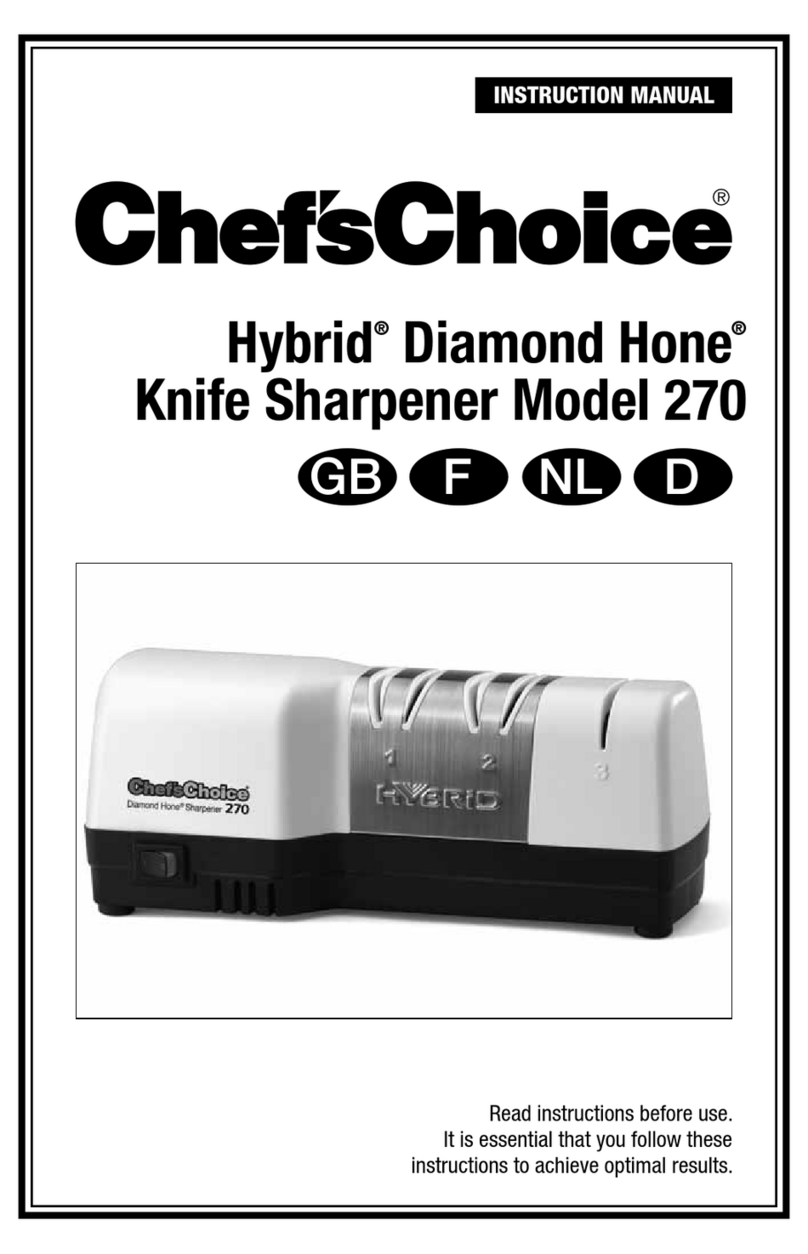
Chef's Choice
Chef's Choice Hybrid Diamond Hone 270 User manual

Chef's Choice
Chef's Choice Hybrid Diamond Hone 220 User manual

Chef's Choice
Chef's Choice G203 User manual

Chef's Choice
Chef's Choice Pronto Diamond Hone 463 User manual
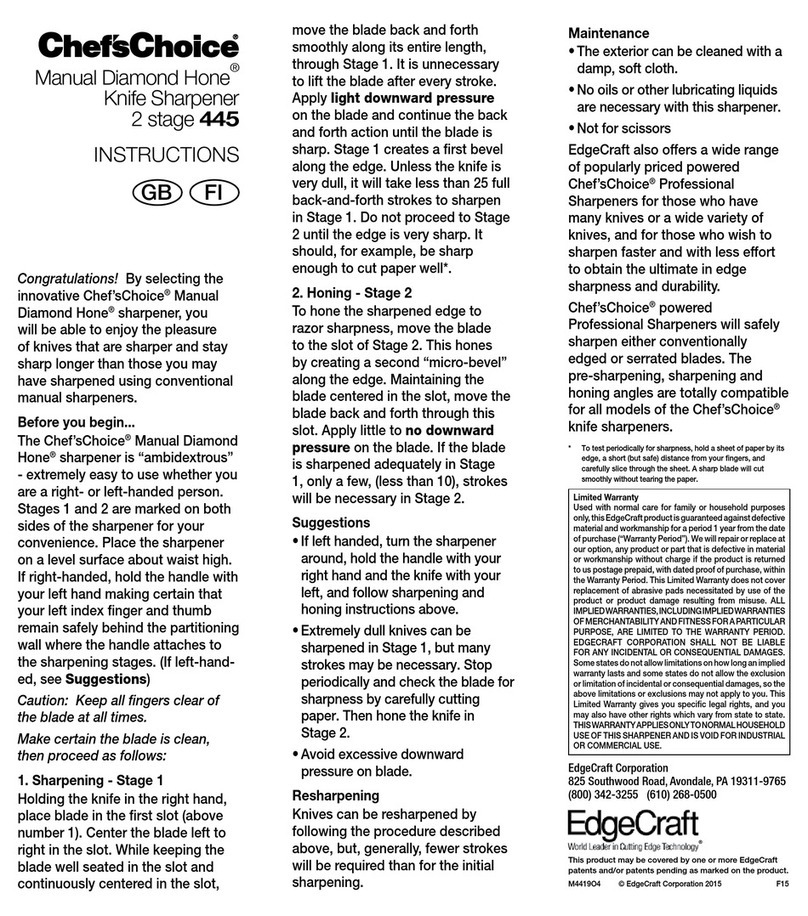
Chef's Choice
Chef's Choice Manual Diamond Hone User manual
